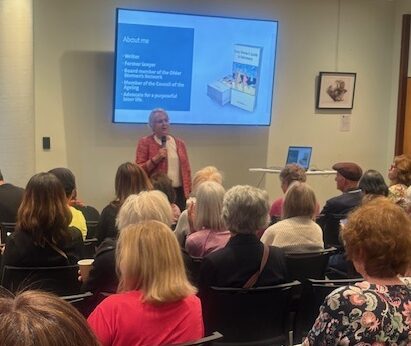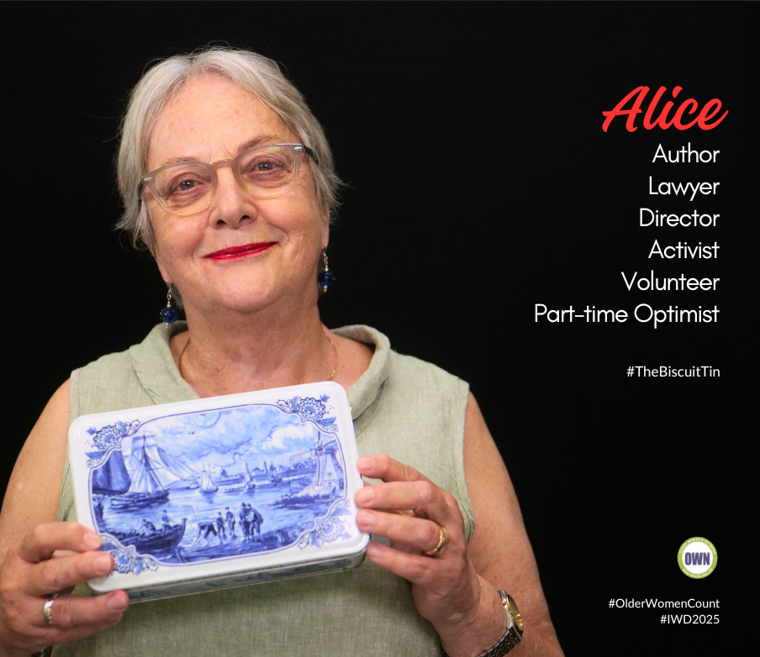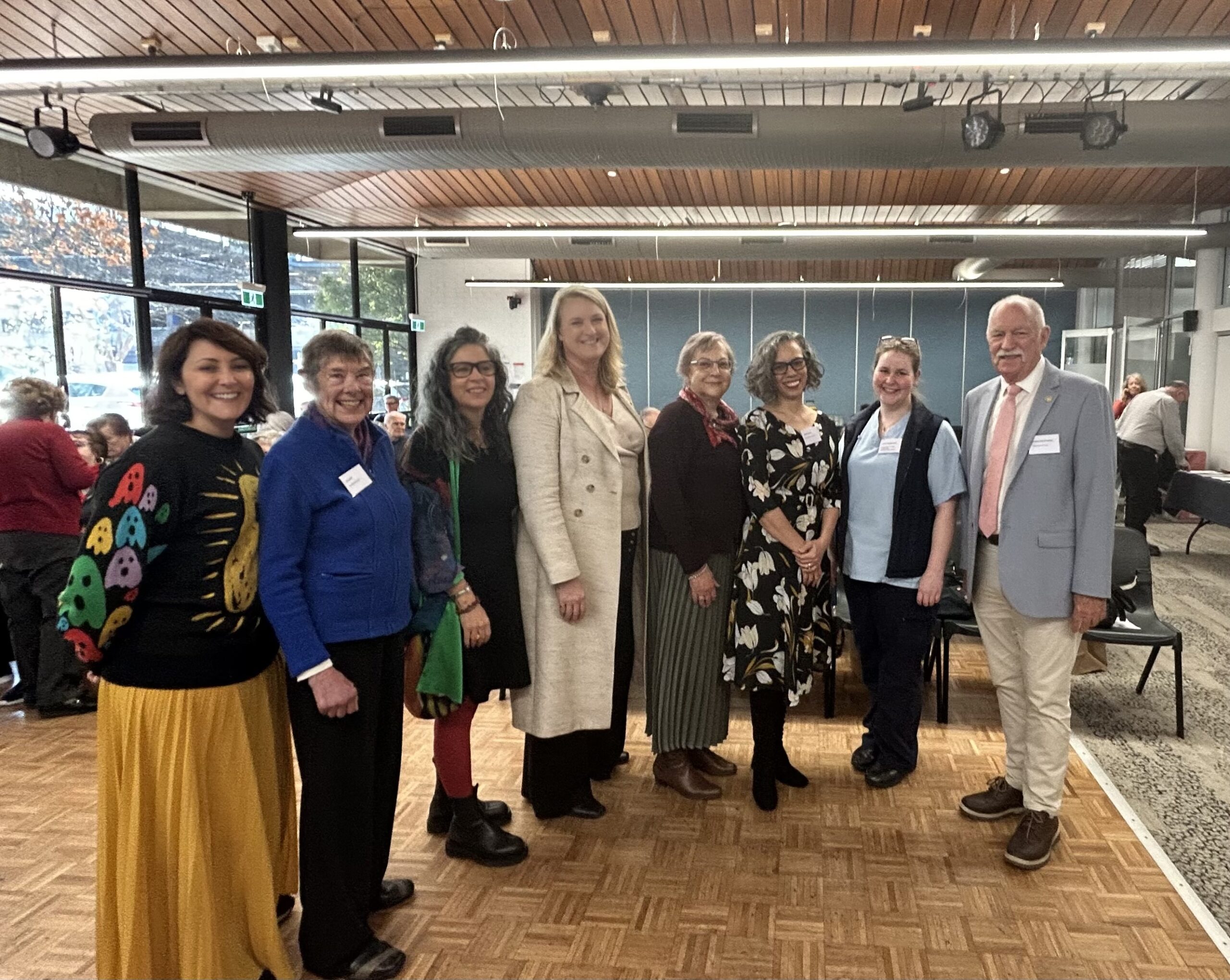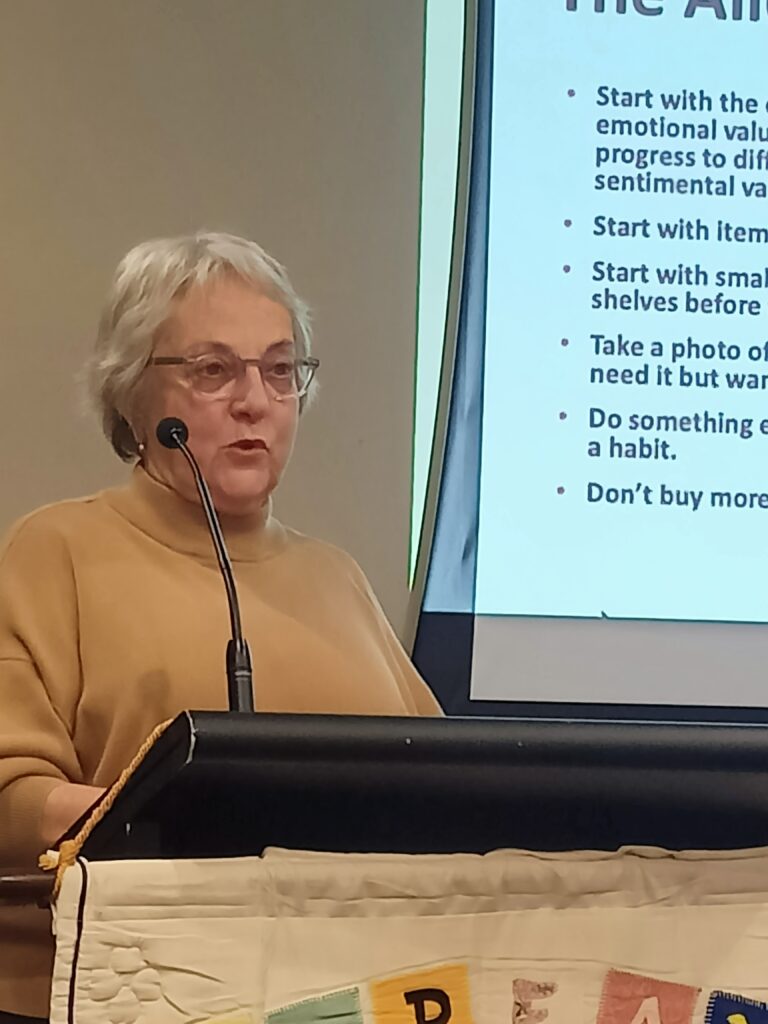 It was a very engaged crowd at the Five Dock library on 12 November. Everyone had a lot to say about the numerous complications that can arise when we get our affairs in order and prepare to simplify things for those people left behind.
It was a very engaged crowd at the Five Dock library on 12 November. Everyone had a lot to say about the numerous complications that can arise when we get our affairs in order and prepare to simplify things for those people left behind.
Author: Alice Mantel
Home Care packages released ahead of schedule
National Seniors Australia (NSA) has welcomed the announcement that 20,000 new Home Care packages will be released ahead of the enaction of the new Aged Care Act on 1 November.
NSA Chief Executive Officer Mr Chris Grice said older Australians waiting for care, and their families, will welcome today’s news which sees the delivery of 40,000 packages up to the end of 2025 and another 43,000 within the first six months of 2026.
“NSA has been advocating for the immediate release of new packages to help begin the process of reducing the home care waiting list – we are glad to see compassion, care, and commonsense prevail,” Mr Grice said. “The release of new packages is recognition that we can’t delay reducing the wait list. It’s a down payment on providing care and support more quickly to older people who need it.
“One of the key recommendations from the Royal Commission into Aged Care Quality and Safety, more than four years ago, was that government should clear the home care wait list so that older people wait only one month for services. The release of new packages inches us closer to that goal.
“There is a question about what level these packages will be. We hope these are not only Level 1 packages, but include packages for people with higher care needs, particularly those stranded in the hospital system.
“The government will still have its work cut out for it to address the tens of thousands of older people waiting for care and waiting to be assessed for care, but the release of 20,000 packages is certainly a start.
“We must remember that it’s not only older people impacted by delays. It’s also loved ones, who provide the support when home care services are not available. “We hope and expect those most in need, including those stuck in hospital, will gain access to these new packages, allowing them to age at home, which is understandably their preference. “NSA thanks all generous individuals who shared their experiences, whose stories helped to shed light on the difficulties faced by older people waiting for care, and the challenges of the many loved ones supporting them. You have made a difference.”
Aged care reform in 2025: An agenda for the next Australian Government

As the first of the baby boomers turn 80 this year, the major parties are on a unity ticket sharing an ideological commitment to the private market and a commitment to make older people pay more for their aged care. Neither party has the details right.
Nearly four years on from the Aged Care Royal Commission, older people and their families are beginning to experience some improvements in the quality and safety of residential aged care. The Albanese government has substantially increased funding, a new funding model has largely stabilised the residential aged care sector and mandated staffing ratios and care minutes are leading to improved staffing and better quality care.
However, access to residential care has become much harder with public hospitals increasingly becoming default aged care providers caring for people waiting weeks to months for an aged care bed. This is having serious flow-on effects both for the older people left waiting for months as well as the medical and surgical patients who are not receiving the clinical care they need because of public hospital bed block.
A new Aged Care Act was introduced in 2024 and will take effect from 1 July 2025. The rights of older people are a central and welcome feature of the new Act.
But the Act is quite high level with the operational detail left to a set of subservient “Aged Care Rules”. Consultation drafts of the Rules have been progressively released as they are being written with comments closing on 13 May 2025. This is a bureaucratic process with no public accountability or oversight by the parliament.
Two months out from the Act taking effect, there are more than 700 pages of draft Rules, making it almost impossible for anyone to absorb them or provide a considered response. The final Rules are likely to be released only days before they take effect. Inevitably, things will go wrong.
While aged care residents will welcome the legislative commitment to their rights, two residential care changes will be less welcome. The first is a substantial increase in the fees and charges that residents will pay. Both major parties share a perception that the baby boomers are cashed up with the financial capacity to pay considerably more.
Indeed, the December 2024 mid year estimates budgeted for a massive $18.8 billion saving in aged care over the forward estimates to be achieved by substantially increasing how much older people pay for their care. This budget saving was supported by the opposition.
However, while many younger boomers may be cashed up, most older boomers are not and both major parties have ruled out touching the family home, which is the only asset for the majority of older people. The average age of entry to residential care is 85 years and only 13% of people 85 and older have more than $100,000 in superannuation. Further, two thirds of people entering aged care are women, who have significantly less superannuation than men. Charging aged care recipients $18.8 billion more in user charges may prove to be unachievable.
While there are protections for full and part pensioners, a typical self-funded retiree moving to residential care and paying a daily accommodation fee can expect to pay more than $120,000 per year in accommodation and care charges from 1 July 2025. There is a lifetime cap of $130,000 on non-clinical user contributions but no lifetime cap on accommodation charges.
The second significant change in residential care is the abolition of existing planning standards and bed licenses for residential care. The availability and location of residential care will now be left to the market with aged care providers effectively free to open and close homes wherever they chose.
The market, not the needs of older people, will determine what residential care will be available. Inevitably this will skew investment into wealthier areas at the expense of people living in lower socioeconomic areas.
However, there is now much more money to be made from investments in the retirement living sector than in residential care and the current aged care bed shortage will only increase as time goes on. This will inevitably result in longer waits and more public hospital bed block. Neither party has a plan for this.
In introducing the new Act, the government argued that less aged care beds will be required in future because more people want to receive their care at home. This makes no sense. It assumes that residential aged care is a lifestyle choice that is now going out of fashion. Older people do not go to residential care as a lifestyle choice. Older people move to residential care when they can no longer live safely at home.
This raises the obvious question about proposed changes to home aged care. There are currently 2.2 million people over 75 in Australia and 1.3 million (60%) currently receive aged care. Only 15% of people receiving aged care are in residential care, the other 85% receive care at home and in the community.
By far the majority of older Australians receiving care at home do not receive an “aged care package”. Instead, they receive services funded through the Commonwealth Home Support Program (CHSP). Each CHSP service receives an annual Commonwealth government grant and these services support 64% of all aged care recipients.
Services such as Meals on Wheels, community transport, neighbourhood day programs and community nursing are provided by not-for-profit community organisations as well as state and local governments and are all funded through CHSP. CHSP recipients are typically lower need and in most cases access services directly rather than through the Commonwealth “my aged care” gateway that channels people to the rest of the aged care system.
But both major parties have been on a unity ticket in running down CHSP in favour of a private for-profit market model known as community aged care “packages” and a growing percentage (currently 21%) of aged care recipients are now receiving a package. This is where the government allocates an older person a budget “package” to pay for their care. This allocation is in effect a cashless credit card earmarked for each individual person. There are currently 275,000 people receiving an aged care package and 85,000 people on the waiting list.
The current package system will be replaced from 1 July 2025 with a new package program called Support at Home. Support at Home differs from existing packages in having more funding levels, less flexibility and significantly higher user charges.
Hundreds of pages of the new Aged Care Rules are devoted to minutiae red tape and regulation about the Support at Home program. The design of the new program significantly increases the transaction and compliance costs for both government and providers, making Support at Home substantially more expensive and less efficient than CHSP. Inevitably these increased costs flow into higher charges for older people and their families as well as increase costs for the Commonwealth.
The 275,000 older people currently receiving a package will be protected from increases in user charges based on a government commitment to current package recipients being “no worse off”. While this is good politics, it further reduces the likelihood that the budgeted government savings will be realised.
This is not the case for those not already on a package. Anyone needing a package will be hit with a sizeable increase in fees and charges.
As just one example, anyone requiring personal care such as assistance with showering and dressing will be charged a co-payment. At an average hourly rate of about $100, full pensioners will pay $5 an hour, part-pensioners $5 to $50 an hour depending on income and self-funded retirees will pay $50 an hour. Fees for domestic assistance will be even higher indicatively ranging up to $76 an hour for self-funded retirees.
The original intention has been that the CHSP would be closed down with the 835,00 people receiving CHSP not for profit and government services being transferred to Support at Home in July 2025 as well. However, Minister Mark Butler announced in 2024 that CHSP would not transition to Support at Home until “at least 2027”.
Setting aside the issue of who pays for what, a key goal of home aged care is to reduce demand for residential aged care. This is where Support at Home is destined to fail. While the inclusion of access to nursing and allied health is welcome and evidence-based, the design of Support at Home ignores the international evidence about how to support older people to live in their own home for as long as possible. That evidence includes rapid response times without long waiting times, nimble and flexible services that can flex up and down in response to changing needs and adequate physical, social and emotional support for family carers. None of these essential features are incorporated into the design of Support at Home.
On the eve of the 2025 federal election, both major parties are on a unity ticket to deliver an aged care system that Australia can afford and that will meet the needs of the tsunami of baby boomers now moving into their 80s. However, both major parties have many details wrong.
The reforms since the Royal Commission have mostly been sensible. But the devil from here is in the detail. The design of the new Support at Home program and intentions to abolish the Commonwealth Home Support Program are not what the Royal Commission recommended and they will not meet the needs or the aspirations of older people. No sensible government would abolish an efficient program with one that costs substantially more, especially in the face of increased demand as the baby boomers reach old age. Yet that is what both major parties are mooting.
Meeting the needs of ageing baby boomers in ways that will not exacerbate intergenerational inequity must be a top priority for the next government. An investment in keeping older people healthy, along with a commitment to maintain and build on the strengths of CHSP, will be an essential first step.
While some older people are happy and capable of managing an aged care package in which their care is treated as a set of financial transactions, the majority of older people living at home want relationship-based care and support from people and organisations they know and trust. Going forward, a sustainable and affordable community aged care system must build on the expertise, culture and reputation of the not-for-profit sector in partnership with state and local governments.
As we move into the next phase of reform, people needing care at home must be given the option of receiving services from grant-funded not for profit providers or a cashless credit card to pay for their services in the private market, whichever they prefer. At the same time, there needs to a capital investment program to ensure that residential aged care is available to all those who cannot live safely at home.
While aged care has not featured in the 2025 federal election campaign, aged care is a sleeper issue for the next government. Older people, their children and their grandchildren represent a powerful political force in Australia. Bold reforms will be required during the next term of government to ensure that Australia’s aged care system is accessible to all who need it, affordable, safe and respectful. An Australian government that ignores aged care for too long does so at its peril.
Kathy Eagar
Advocating for advocacy
Often older people feel that their voice is not being heard. At this COTA event, Alice is giving a few tips at being a more effective advocate.

Seen at the Older Women’s Network Biscuit Day

Financial reforms under the new Aged Care Act
The new Aged Care Act 2024 is expected to commence from 1 July 2025. This article attempts to explain the changes that are likely to happen in relation to residential care focusing on consumer contributions and means testing.
The intention of this major revision of the existing Aged Care Act is to:
- improve the lives of older people accessing aged care services in their homes, community settings and residential aged care homes;
- encourage aged care providers to deliver high-quality care.
The proposed rights-based law:
- addresses approximately 60 Royal Commission into Aged Care Quality and Safety recommendations;
- incorporates feedback from several public consultations about proposed aged care reforms;
- responds to the Aged Care Taskforce about sustainably funding aged care into the future.
However, for most people, the most important, and not finalised, changes will relate to the expected cost of receiving care – whether that is at home or when resident in an aged care facility. The proposed changes appear to focus on the resident’s financial disclosure responsibilities and an onerous assessment process that are likely to result in a very large increase in the cost of receiving aged care services. At this stage (February 2025) the details have not yet been finalised and it is likely that more changes will be made.
Means testing reforms
The reforms consist of:
- means testing the hotelling supplement which is currently paid in full by government;
- abolishing the current means tested care fee and associated annual and lifetime caps;
- introducing a new means tested contribution to non-clinical care, including a new daily cap on payments and a new lifetime cap;
- mandatory reporting to keep residents’ means assessments current.
The no worse-off principle
- A no worse-off principle will apply to everyone in residential aged care on 30 June 2025.
- Existing residents retain their existing contribution arrangements for the entirety of their stay in residential care.
What will stay the same
The government will continue to fund the majority of aged care. All residents will continue to pay a Basic Daily Fee. The way different types of income and assets are assessed in the residential aged care means assessment will not change. Current financial hardship assistance arrangements will continue.
What will change
Means testing – Current means tested care fee will be abolished • Introduction of Hotelling Contribution • introduction of Non-Clinical Care Contribution • Mandatory reporting • accommodation costs • Grandparenting of fee arrangements.
Changes to means testing – A resident’s means tested amount is based on their assessable income and assets. It will continue to be the sum of their income tested amount and asset tested amount. Income and asset taper rates are changing.
Hotelling Supplement contribution – Starting 1 July 2025, the Hotelling Supplement will be means tested for new residents. Residents who can afford to pay their full accommodation costs will contribute to daily living costs such as food, cleaning, laundry and utilities.
The means test will require a contribution from residents with:
- assets over $238,000, or
- income over $95,400, or a combination of both.
The contribution will be up to the maximum Hotelling Supplement of $12.55 per day (20 September 2024 rates). The government will pay providers the difference.
Non-Clinical Care Contribution – The Government will fully fund all clinical care costs in residential aged care. For new residents from 1 July 2025, the new means-tested Non-Clinical Care Contribution (NCCC) will replace the Means Tested Care Fee. This contribution will be for non-clinical care costs such as bathing, mobility assistance and lifestyle activities. It will only apply to residents who can afford to pay the full Hotelling Supplement contribution.
The non-clinical care means test will require a contribution of 7.8% of assets over $502,981 or 50% of income over $131,279 or a combination of the two up to a daily limit of $101.16. It is paid until the resident has contributed $130,000 or been in residential aged care for 4 years, whichever occurs first. The government will pay the difference.
Mandatory reporting – Providers will regularly report individual refundable deposit balances. Residents will be required to report changes to their personal and financial circumstances. Residents can elect to be classified ‘means not disclosed’ and consequently won’t be asked to report financial circumstances, will not be eligible for government support with accommodation costs or Non-Clinical Care Contribution. They can later elect to complete a means assessment but this cannot be back-dated to their entry to care.
Grandparenting for current residents -The current fee arrangements will continue for residents already in care before 1 July 2025. This includes the: pre 1 July 2014 cohort and the post 1 July 2014 cohort. Individuals will be able to ‘opt out’ of their grandparented fee arrangements at any time.
Dying to know day was a lively event
 COTA organised Dying to Know Day (August 8th) COTA under the auspices of North Sydney MP, Kylea Tink. NSW member and dying well advocate Jill Nash co-organised a fantastic line up of speakers to discuss Death, Dying and Grief.
COTA organised Dying to Know Day (August 8th) COTA under the auspices of North Sydney MP, Kylea Tink. NSW member and dying well advocate Jill Nash co-organised a fantastic line up of speakers to discuss Death, Dying and Grief.
Jill spoke poignantly about the loss of her baby daughter and then her husband when she was just 41. Informed by these traumatic experiences, Jill is taking control of her future by gathering information and documents and starting personal conversations now, so that her family are prepared for her death and dying when the time comes.
Alice Mantel, another COTA NSW member, also shared her specialist legal expertise on how to go about getting your affairs in order many years before you may think you will need to.
Alice is also the featured expert in the Planning for the Unexpected series produced by OWN NSW.
Over half a million older people experienced abuse in the last year
Latest data released by the Australian Institute of Health & Welfarehttps://www.aihw.gov.au/family-domestic-and-sexual-violence/population-groups/older-people#:~:text=In%20institutional%20settings%2C%20Yon%20et,and%20sexual%20abuse%20(1.9%25). (AIHW) has made some key findings that show people in Australia are at increased risk of abuse in their later years. This abuse can take many forms, including psychological or emotional abuse, financial abuse, physical abuse, sexual abuse, and neglect.
Key findings of the most recent data:
- 1 in 6 (15% or 598,000) people in Australia experienced elder abuse in the past year.
- psychological abuse is the most common form of elder abuse.
- 1 in 2 people who perpetrate elder abuse are a family member.
- 1 in 3 people who experienced elder abuse sought help from a third party.
As Australia’s population ages, the number of older people in Australia experiencing abuse is likely to increase over time. A key aspect of the definition is that elder abuse occurs in relationships where there is “an expectation of trust”. Such relationships include those with family members, friends, neighbours, and some professionals such as paid carers.
Prevalence estimates are likely to underestimate the true extent of elder abuse. This is because victim-survivors can be reluctant to disclose ill-treatment by a family member, or because they are dependent on the abuser for care. Older people with cognitive impairment (for example, dementia) or other forms of disability may also be unable to report abuse.
Evidence from international studies show that abuse estimates are higher for older people in institutional settings than in the community. A 2017 review found that there is a greater likelihood for women being abused (17%) than men (11%) with sons also more likely to perpetrate abuse than daughters.
What kind of abuse is perpetrated?
The AIFS National Elder Abuse Prevalence Studyhttps://aifs.gov.au/research/research-reports/national-elder-abuse-prevalence-study-final-report estimated that, in 2020:
- around 1 in 6 (598,000 or 15%) older people living in the community had experienced elder abuse in the past year
- 471,300 (12%) had experienced psychological abuse in the past year
- 115,500 (2.9%) had experienced neglect in the past year
- 83,800 (2.1%) had experienced financial abuse in the past year
- 71,900 (1.8%) had experienced physical abuse in the past year
- 39,500 (1.0%) had experienced sexual abuse in the past year
- a slightly higher percentage of women than men had experienced any form of elder abuse in the past year. This pattern was also evident for psychological abuse and neglect.
Who are the perpetrators?
Around 1 in 2 (53%) perpetrators of elder abuse were family members (includes ex-partner/spouses). Perpetration by family members was highest for financial abuse (64%) then neglect (60%), psychological abuse (55%), physical abuse (50%) and sexual abuse (15%). Sexual abuse of older people was primarily perpetrated by friends (42%), acquaintances (13%) and neighbours (9%).
Support for abused persons
The AIFS study estimated that:
- 1 in 3 (36%) older people in Australia who experienced abuse sought help or advice from a third party such as a family member, friend or professional;
- help seeking was most common after physical abuse, followed by psychological abuse, financial abuse, sexual abuse and then neglect;
- of those seeking help, the most common sources of help were family members (41%) and friends (41%), followed by a GP or nurse (29%), a professional carer (24%), the police (17%) and lawyers (15%). Around 1 in 20 (5.3%) contacted a helpline.
Around 8 in 10 (82%) older people who experienced abuse had taken action to stop the abuse from happening again. These actions included informal actions (such as speaking to the person) and formal actions (such as seeking legal advice). The most common actions were speaking to the person or breaking contact with them.
If you, or someone you know has been abused, you can call 1800 ELDERHelp.
Decluttering – or the art of having less stuff.
Giving a talk at the Nepean-Hawkesbury VIEW Club on 17 June 2024.

Tune in to this series of podcasts – Planning for the Unexpected
Join me and my co-host Amanda Armstrong as we take you through this series of six podcasts which can help you to be better prepared for those unexpected life events.
Podcasts can be found on YouTube.
This series is presented on behalf of the Older Women’s Network.
Death is of course, inevitable, but often it is unexpected. Most of us would rather not think too much about it. But planning for the unexpected can be liberating. It allows you to enjoy life because you have removed a future burden for yourself and your loved ones.
This new series from OWN presented by family lawyer Alice Mantel will take you through what you need to organise before you die, from writing a will, family conversations and decluttering. It can be a baffling area, and easy to put in the too hard basket for now. This practical and reassuring series will break down the steps and give you tips to approach planning for the unexpected in a positive and proactive way.
Preparing for the unexpected – Wills, Power of Attorney, Enduring Guardianships and more – Episode 1.
The gentle art of decluttering – Episode 2
https://www.youtube.com/watch?v=C9TkNtu2WMA&pp=ygUacGxhbm5pbmcgZm9yIHRoZSB1bmV4cGVjdGU%3D
How is your financial health – Episode 3
Suddenly single – Episode 4
https://youtu.be/trNaxaNIjJA
